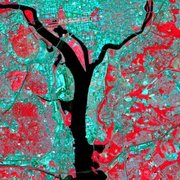Landsat 7
|
|
Landsat7patch.jpg
Landsat 7 Mission Patch.
Landsat 7 is the latest satellite of the Landsat program. It was launched on April 15th, 1999. The primary goal of Landsat 7 is to refresh the global archive of satellite photos, providing up-to-date and cloud free images. Although the Landsat Program is managed by NASA, data from Landsat 7 is collected and distributed by the USGS. The NASA World Wind project allows 3D images from Landsat 7 and other sources to be freely navigated and viewed from any angle.
| Contents |
Satellite specifications
Landsat7schematic.png
Landsat 7 Schematic.
Landsat 7 was designed to last for five years, and has the capacity to collect and transmit up to 532 images per day. It is in a polar, sun-synchronous orbit, meaning it scans across the entire earth's surface. It takes 232 orbits, or 15 days, to do so. The satellite weighs 1973 kg, is 4.04 m long, and 2.74 m in diameter. Unlike its predecessors, Landsat 7 has a solid state memory of 378 gigabits (roughly 100 images). The main instrument on board Landsat 7 is the Enhanced Thematic Mapper Plus (ETM+).
Main features
- A panchromatic band with 15m spatial resolution
- Full aperture, 5% absolute radiometric calibration
- A thermal infrared channel with 60 m spatial resolution
SLC Failure
On May 31, 2003 the Scan Line Corrector (SLC) in this instrument failed. The effect of this is that the raster scanning of the image is angled rather than parallel, causing narrow bands of each image not to be acquired. As of 2004 the images are being released with the missing points filled with previous years' data. This may change later to use data acquired at a few weeks' interval. To continue the Landsat legacy, studies are underway to fly an equivalent scientific sensor on an NPOESS satellite towards the end of this decade.
External links
- NASA's Landsat 7 Website (http://landsat.gsfc.nasa.gov/)
- The USGS' Landsat Website (http://landsat.usgs.gov/index.php)
- EarthSat's NaturalVue 2000: Global natural color satellite imagery coverage (resolution 15 m), based on Landsat 7 data acquired between 1999 and 2001 (http://www.earthsat.com/HTML/naturalvue/)
- NASA's WorldWind Project (http://worldwind.arc.nasa.gov/) World Wind lets you zoom from satellite altitude into any place on Earth. Leveraging Landsat satellite imagery and Shuttle Radar Topography Mission data, World Wind lets you experience Earth terrain in visually rich 3D.de:Landsat 7


